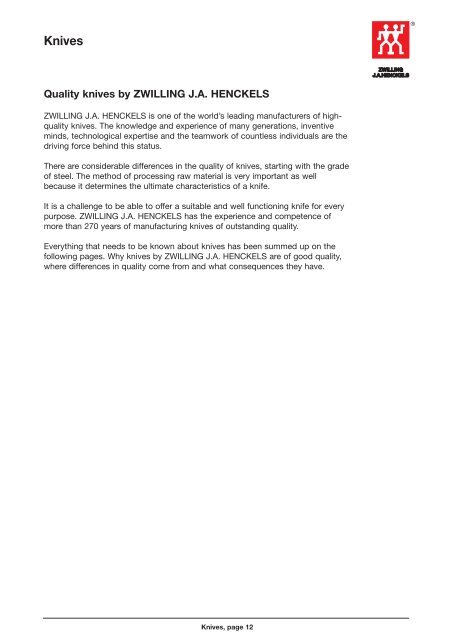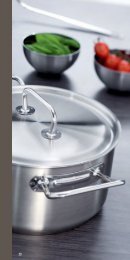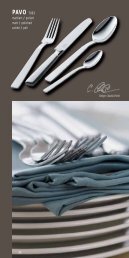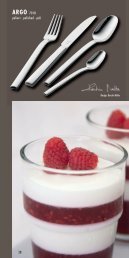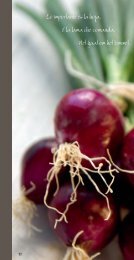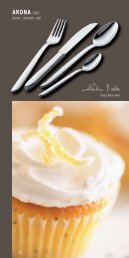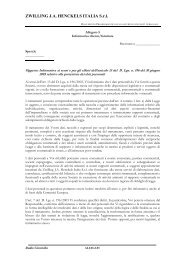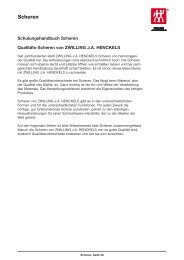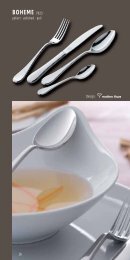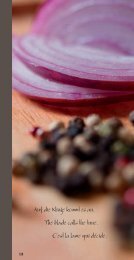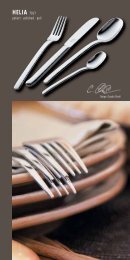Download this chapter as PDF - Home - ZWILLING JA HENCKELS ...
Download this chapter as PDF - Home - ZWILLING JA HENCKELS ...
Download this chapter as PDF - Home - ZWILLING JA HENCKELS ...
Create successful ePaper yourself
Turn your PDF publications into a flip-book with our unique Google optimized e-Paper software.
Knives®Knives: Terminology1. The knife edgeThe cutting part of the blade is called edge.Since knives are required to perform a variety of t<strong>as</strong>ks, blades have been developedwith varying types of edge.Fine-edge bladeFine-edged blades produce a smooth, clean cut without causing the product todisintegrate. They are suitable for cutting hard and soft materials such <strong>as</strong> vegetables,meat, fruit. A fine-edged blade is also needed for peeling.Serrated edge bladeThis edge is useful for cutting and slicing soft products with a tough skin, e.g.tomatoes. The serration penetrates more e<strong>as</strong>ily than a fine edge. However, whenslicing meat, fruit and vegetables of a fibrous texture, the cut of a fine blade isgentler.Scalloped edge bladeThis is a special serration that is b<strong>as</strong>ically used for the same jobs <strong>as</strong> the serratededge. It is particularly suitable for cutting bread (penetrating hard crusts andslicing the soft interior).Knives, page 14
Knives®Knives: TerminologyHollow-ground edge bladeThe name derives from the hollows positioned alternately on each side of theblade, giving the knife a particularly fine cutting edge. When used for cutting, airpockets develop in the hollows with the result that the product separates e<strong>as</strong>ilyfrom the blade. Thus very fine slices (e.g. ham) can be cut effortlessly. Evenshort-crust p<strong>as</strong>try and flan b<strong>as</strong>es can e<strong>as</strong>ily be sliced into thin and even layers.Razor edge bladeFollowing intensive research <strong>ZWILLING</strong> J.A. <strong>HENCKELS</strong> h<strong>as</strong> developed an innovatinghoning technique that guarantees an extremely high initial cutting performance.After grinding, the blade gets a fine-polish treatment to remove even thetiniest burrs. This technique is mainly used for the Asian-style knives (e.g.Santoku knife).Knives, page 15
Knives®Knives: Terminology2. Knife tips: shapes with functionsThree shapes can be distinguished:High tipThe back of the blade is straight while the cutting edge is curved, e.g. on a utilityknife. This shape permits the blade to be raised from the cutting board with arolling action.Centre tipBoth the back of the blade and the cutting edge are gently curved, terminating ina point. With a pronounced tip like <strong>this</strong> (e.g. on a chef’s paring knife) the bladecan e<strong>as</strong>ily be used to lard a ro<strong>as</strong>t with bacon or herbs.Low tipThe back of the blade is curved while the cutting edge runs straight up to thepoint. This shape permits smooth, straight cutting on a cutting board without anychopping action (e.g. with the vegetable knife).Knives, page 16
Knives®Knives: Terminology3. Blade profileThe initial sharpness essentially depends on the profile of the blade and theshape of the cutting edge. The durability depends on the composition of thesteel and its heat treatment.Durability stands for the effective cutting life of the blade.There are two types of profiles with differing characteristics.a) The evenly tapered profileThis shape is ideal because- the cutting edge is stabilised and- it is e<strong>as</strong>ily re-sharpened.This shape is therefore being used for knives by <strong>ZWILLING</strong> J.A. <strong>HENCKELS</strong>.b) The hollow-ground profileThis shape is unsatisfactory because the edge- h<strong>as</strong> insufficiently stability and- is therefore e<strong>as</strong>ily damaged.Knives, page 17
Knives®Knives: Terminology4. The tangThe tang is the part of the blade which extends into to handle. There are two differenttypes: the concealed tang (e.g. Four Star series) and the exposed tang(Professional “S” series). Concerning the latter a distinction is made between afull, half and quarter tang, depending on its length.The concealed tang is c<strong>as</strong>t into the pl<strong>as</strong>tic handle and additionally safely securedwith synthetic resin. The exposed tang’s rivets have the purpose of connectingthe handle or scales with the tang.Knives, page 18
®KnivesKnives: ErgonomicsOutstanding design combined with perfect functionalityThe shape of the handle determines whether a knife feels comfortable and ise<strong>as</strong>y to use. To a large extent an ergonomically shaped handle fits the naturalshape of the hand.When you pick up a knife you can quickly tell whether it suits you.<strong>ZWILLING</strong> J.A. <strong>HENCKELS</strong> pays particular attention to combine outstandingdesign with ergonomic principles.The balance of a knife or the proper distribution of weight between the handleand the blade plays an important role. To be able to use the knife for a prolongedperiod of time without causing discomfort or strain, the handle must be wellshaped and neatly finished.A well designed handle h<strong>as</strong> a distinct finger guard to give the hand a secure grip.The finger guard is either integrated into the handle or, in the c<strong>as</strong>e of topquality knives, designed <strong>as</strong> a steel part (bolster).Following the improvements in properties of pl<strong>as</strong>tic compound over the years -particularly under hygienic <strong>as</strong>pects – polypropylene handles have incre<strong>as</strong>inglyreplaced wooden handles.Polypropylene handles have a number of advantages:- impact and shock resistance- best possible hygiene due to the smooth and pore-free surface- dishw<strong>as</strong>her-safe.Knives, page 26


